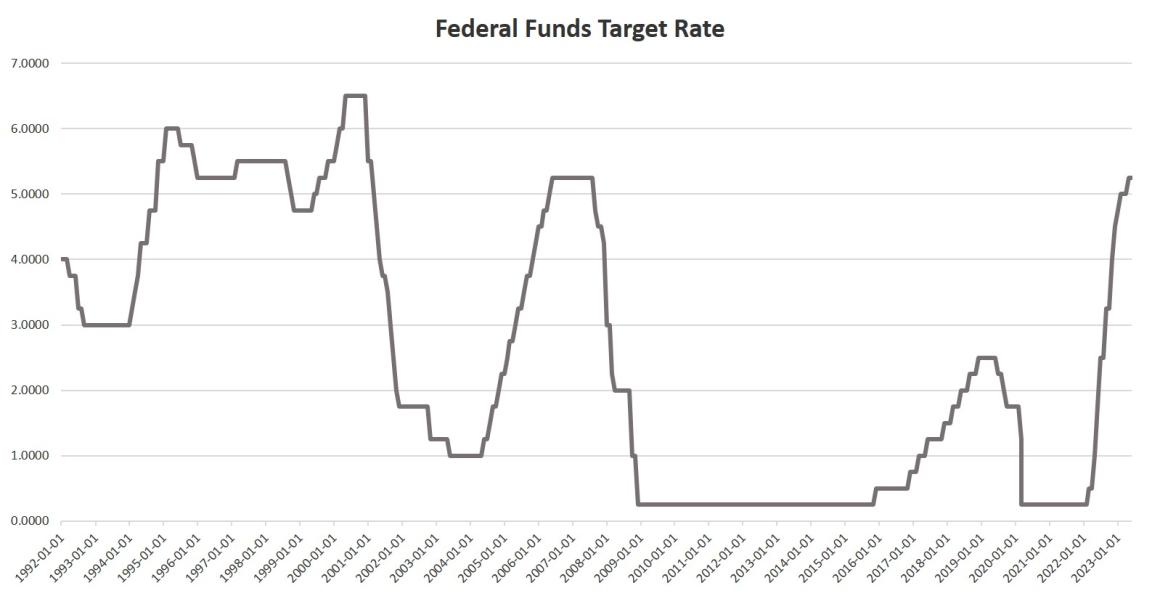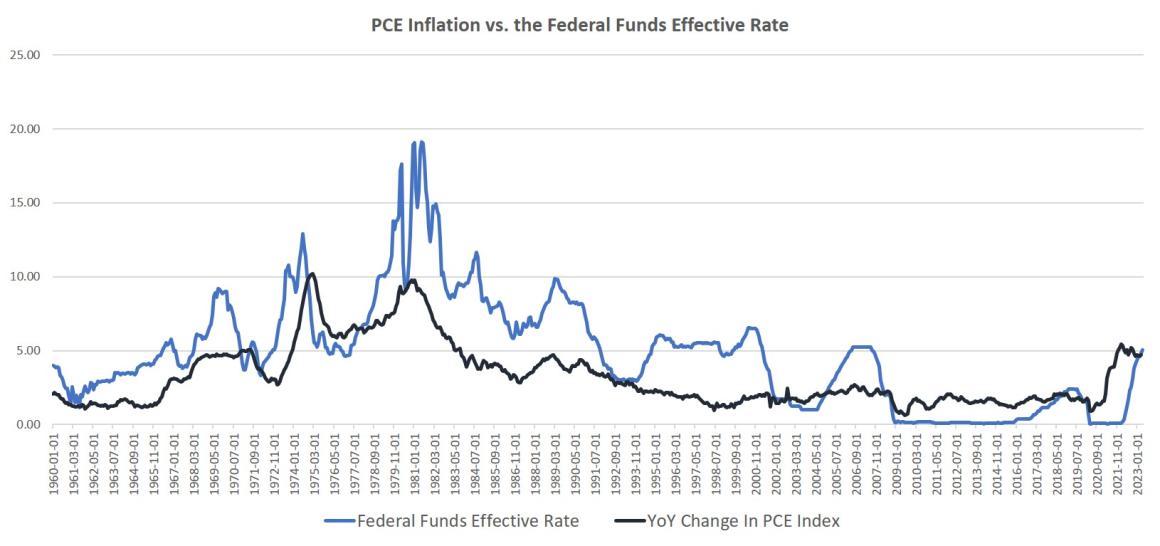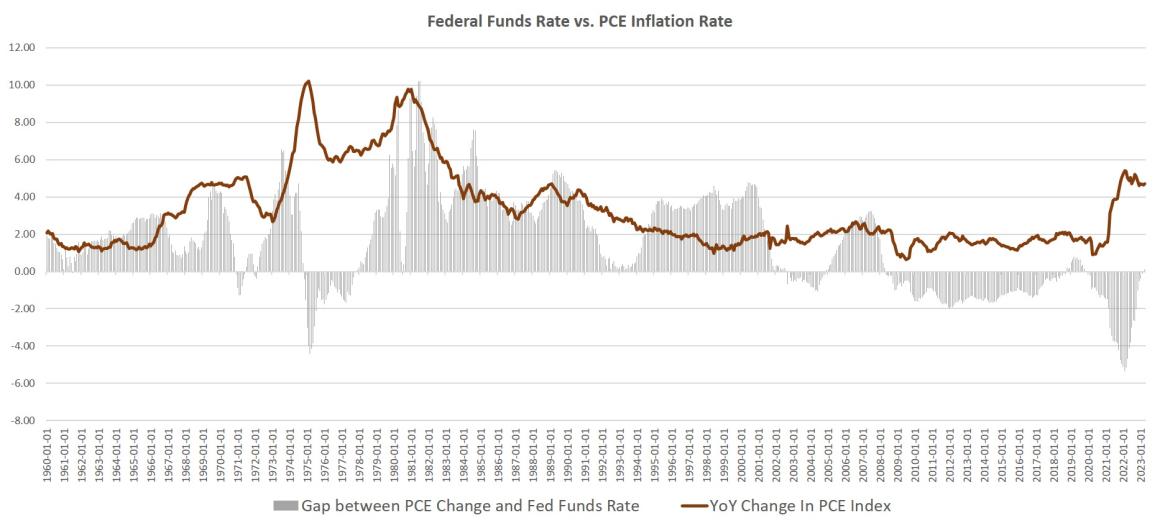The Federal Reserve’s Federal Open Market Committee (FOMC) on Wednesday left the target policy interest rate (the federal funds rate) unchanged at 5.25 percent. This "pause" in the target rate suggests the FOMC believes it has raised the target rate high enough to rein in price inflation which has run well above the Fed's arbitrary two-percent inflation target since mid-2021.
Yet, at Wednesday's press conference announcing the FOMC's decision, Fed Chair Jerome Powell also claimed that "Inflation remains well above our longer-run 2 percent goal" and "inflation pressures continue to run high and the process of getting inflation back down to 2 percent has a long way to go."
Moreover, according to Powell, the labor market is red hot, with Powell stating "The labor market remains very tight" and "labor demand still substantially exceeds the supply of available workers."
The Fed Wants It Both Ways
Both of these sentiments suggest that the Fed should keep allowing the target rate to rise. After all, if job demand is so high, that means continued increases to wage costs for employers plus more consumer demand for goods and services. That suggests more price inflation. Meanwhile, if measures of price inflation show that we have "a long way to go" that also suggests the Fed should keep allowing rates to rise.
In other words, all the facts presented by Powell himself point to a need for the Fed to stop pushing down interest rates and let them rise further. Yet, the Fed, for some reason, has decided now is a good time to hold the rate steady at 5.25 percent.
The Fed is certainly sending mixed messages, and apparently wants to have it both ways. Powell wants to announce he and the FOMC are firmly committed to combating price inflation by allowing interest rates to rise—and, by the way, allowing more securities to roll off the Fed's $8.3 trillion balance sheet. At the same time, Powell also wants to claim that now is a good time to pause on rate hikes, even though the Fed's favored PCE measure of price inflation is more than double the Fed's target rate of two percent.
[Read More: "Powell Explains the Pause" by Robert Aro]
Of course, the reason for muddled messaging is not completely mysterious. The answer lies in examining the political situation. Fantasies about "fed independence" might blind some observers to the reality, but the Fed is a profoundly political institution, and must juggle a variety of political pressures. As it is, the Fed must seem like it is "doing something" about price inflation while simultaneously avoiding any moves that will cause the economy to slow to the point where it becomes politically problematic for the administration. The incoherence we now see from Powell is a direct result of the Fed's desire to send several conflicting messages at once.
The Fed Rarely Resumes Substantial Hikes after a "Pause"
For cynical veteran Fed watchers, the pause immediately raises the question of whether or not this will turn out to be a permanent pause, followed in, say, six months by a drop in the target interest rate. After all, historical experience shows that when the Fed "pauses" it rarely goes back to any sort of sustained period of monetary tightening.
Over the past thirty years, there have only been a few occasions during which the Fed paused for more than a single month, and then went back to allowing the target rate to move upward again. This occurred briefly in 2017, and in 1996 and 1997. In the quantitative tightening period between the Dot-com Bust and the Great Recession, however, the Fed never "paused" longer than a single month. If the Fed fails to allow rates to climb again next month, we'll have good reason to suspect that the Fed is done with this current round of rate hikes.
So, now that the FOMC has "paused," will it ever start up with rate hikes again? The odds are against it, but it is possible. It will all come down to how much the Fed fears that price inflation will again head upward to politically damaging levels. That fear, after all, is the only reason the Fed has ever entertained the idea of allowing rates to rise anywhere near the current level of 5.25 percent. The last decade has shown us that the Fed clings to a bias very much in favor of ramming down interest rates again and again. This is what happened in the ten years of near-zero rates that followed the 2008 financial crisis. Every month, the FOMC would come out and say that the economy was "growing" and was showing "strength" yet repeatedly refused to raise rates.
The Fed Is Making It Up as It Goes
This Fed's contradictory messages are so apparent that even some members of the media asked why the Fed is bothering to pause at all. As one reporter asked at the press conference, "what's the value in pausing and signaling future hikes versus just hiking? … so why not just rip off the Band-Aid and raise rates today?"
Powell's answer was to admit that the Fed and its legions of economists don't actually know what the results will be of the Fed's tightening, so they're just going to take a wait-and-see attitude. This non-response from Powell highlights the fact that the Fed has long since abandoned its claim to have in place some kind of long-term plan for monetary policy. Gone are the days of "forward guidance" and we're now in the days of "we'll tinker with the economy and see what happens next."
This makes sense given that a look back at the FOMC's economic projects have been very, very wrong in recent years. According to the FOMC's Summary of Economic Projections (SEP) from September 2020, for example, every FOMC member but one predicted that the target interest rate in 2022 would remain at 0.25 percent, with only one member venturing to suggest that the rate might get up to 0.75 percent in 2022. Projections for 2023 were not much more accurate with only three FOMC members predicting that the target rate would rise above 0.25 percent. By March 2022, most FOMC members were still predicting that the target rate in 2022 would be below three percent, and only five members guessed the rate might exceed three percent in 2023. Members were also way off on projections about price inflation and GDP growth.
The Fed Has Kept the Target Interest Rate Very Low for a Very Long Time
In fact, the Fed was so committed to ultra-low rates between 2008 and 2023 that the mismatch between price inflation rates and the federal funds rate was larger than anything we've ever seen before. That is, if we compare the federal funds rate to the Fed's favored measure of price inflation—PCE inflation—we see that historically, the target rate was usually above the PCE inflation rate. The exceptions were in periods we know to be inflationary, such as in the mid 1970s under the Burns Fed.
If we look at this gap between the PCE and the target rate, however, the period between 2008 and 2023 really stands out as a remarkably long period during which the target interest rate remained at rock-bottom levels, well below the official price inflation rate. Indeed, this graph shows that going back at least as far as 1960, no other period comes even close to keeping the target rate so far below the price inflation rate for so long. Out of 177 months since the 2008 financial crisis was revving up in August 2008, only 16 months have seen the target interest rate rise above the official inflation rate.
With all that easy money sloshing around for so long, we can see that FOMC members have good reason to fear that inflation has not yet been tamed.
There Is No Fed "Independence." Politics Is Guiding Fed Policy.
On the other hand, the Fed will encounter immense opposition to ongoing rate hikes if the economy obviously slows. But how to decide if the economy is getting "bad" or not? A lot will depend on whether or not policymakers at the Fed and in the federal government actually believe that the labor market is as tight as Powell has repeatedly insisted.
As I noted in a recent article on the jobs data, the Fed only ever refers to the job-growth data from the establishment survey. Powell conveniently ignores the data from the household survey which has actually shown a collapse in self-employment, and several declines in total employed persons in recent months. The establishment survey's job-growth data is among the few economic indicators pointing to a strong economy right now. Numerous other indicators of manufacturing activity, consumer debt, bankruptcies, and the yield curve all point to economic trouble. If we consider these other metrics—and not just the Fed's rosy labor picture—then the Fed pause is more easily explained: the Fed is pausing out of fear of weakening the economy to the point of alarming voters.
With the Fed, however, what Powell says publicly, and what is actually going on behind the scenes, are two different things. We can only guess what their real motivations are. It is a safe bet, however, that the Fed is trying to thread a needly here in which it somehow manages to bring down price inflation while also allowing the Biden administration to claim that the economy is in great shape. What happens next will depend heavily on what the regime will feel is necessary to buoy public support for the regime and its current ruling party.
Full story here Are you the author? Previous post See more for Next postTags: Featured,newsletter





























